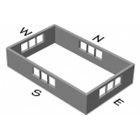
Today’s energy-efficient windows can dramatically lower the heating and cooling costs associated with windows while increasing occupant comfort and minimizing window surface condensation problems. However, consumers are often confused about how to pick the most efficient window for a residence. Product information typically offers window properties: U-factors or R-values, Solar Heat Gain Coefficients or Shading Coefficients, and air leakage rates. However, the relative importance of these properties depends on site- and building-specific conditions. Furthermore, these properties are based on static evaluation conditions that are very different from the real situation a window will be used in.
A computer tool such as RESFEN can help consumers and builders pick the most energy-efficient and cost-effective window for a given application, whether it is a new home, an addition, or a window replacement. It calculates heating and cooling energy use and associated costs as well as peak heating and cooling demand for specific window products. Users define a specific “scenario” by specifying house type (single-story or two-story), geographic location, orientation, electricity and gas cost, and building configuration details (such as wall, floor, and HVAC system type). Users also specify size, shading, and thermal properties of the window they wish to investigate. The thermal properties that RESFEN requires are: U-factor, Solar Heat Gain Coefficient, and air leakage rate. RESFEN calculates the energy and cost implications of the window compared to an insulated wall. The relative energy and cost impacts of two different windows can be compared.